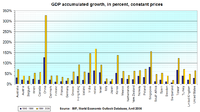
Photo from wikipedia
Abstract Transport infrastructure and planning decisions are noted to directly influence the physical, social and economic landscape of cities over a period of time. Little is however known about how… Click to show full abstract
Abstract Transport infrastructure and planning decisions are noted to directly influence the physical, social and economic landscape of cities over a period of time. Little is however known about how such interventions positively or negatively affect land use, growth and form of African cities. This is deemed important to assist a re-framing of the urban transport debate by emphasising accessibility as the underlying objective of transport in cities. In response to this gap, the paper examines the dynamics of development, growth and change, phased in two periods (colonial and post-colonial) using transport as a lens in a Ghanaian city of Kumasi. Premised on an extensive review of relevant literature, findings indicate that planning decisions and investments in transport infrastructure have resulted in an extensive change of the city’s landscape, form and growth which have had implications on and resulted in congestion and peri-urbanisation, deteriorating environmental conditions, segregation, informality and accessibility and decay of the urban landscape. Evidence of weak and inadequate planning and policy responses were revealed, a situation that has contributed to the city’s inability to manage the adverse outcomes of transport impacts in the city. The paper concludes that since transport has a multiplier effect on the morphology and development of cities, the use of smart growth management principles are necessary to increasingly reflect orderly development, and tolerable densities to achieve a liveable and sustainable environment.
Journal Title: Case studies on transport policy
Year Published: 2019
Link to full text (if available)
Share on Social Media: Sign Up to like & get
recommendations!